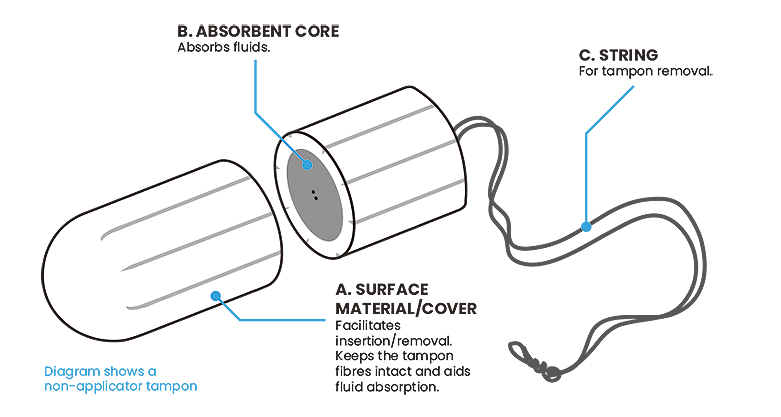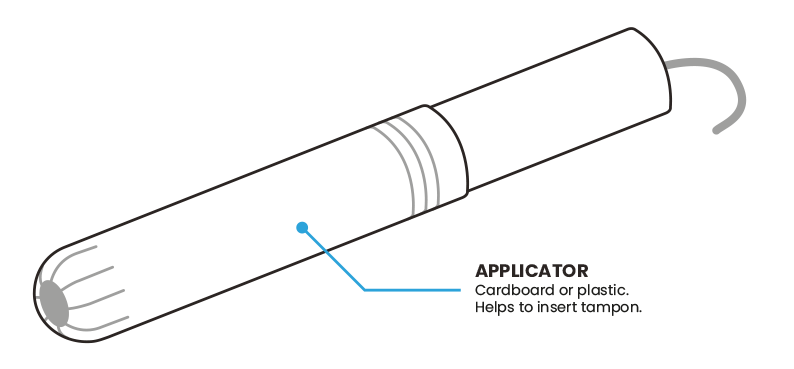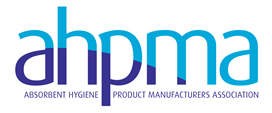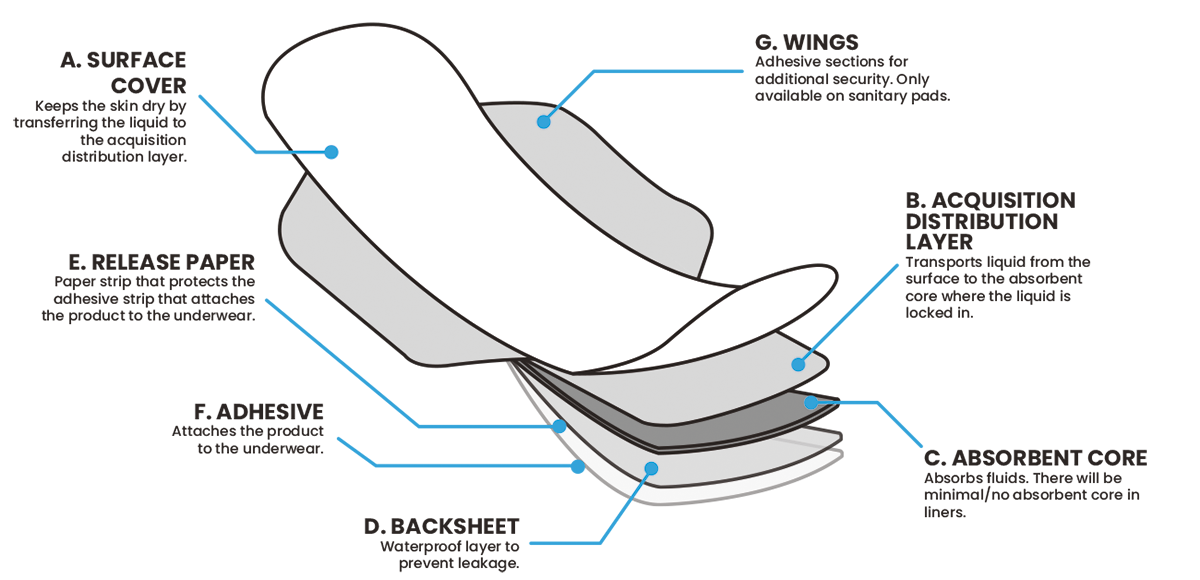Feminine Hygiene
Disposable feminine hygiene products fall into two main categories: internal protection (tampons) and external protection (pads and pant liners.)
PADS AND LINERS
Pads and pant liners are available in a wide range of styles and absorbencies. Pads are designed for use during menstruation. Pant liners are designed for daily use or to give added protection when used in combination with a tampon, or for very light flow at the beginning or end of a menstrual period.
Pads and pant liners have a surface cover designed to provide comfort and keep the skin dry and clean. There is an absorbent core with or without superabsorbent polymer (SAP) to absorb and lock in fluid. There is a waterproof backsheet typically with adhesive for attachment to the underwear.
Both pads and liners may have other design features such as layers coloured by inks, pigments or dyes used in small amounts to assist in the identification of components, for ease of use and to make the products more appealing to use. They may be fragranced (generally indicated on the pack) and some pads may contain some odour-absorbing ingredients.
Click the image to enlarge
EXAMPLES OF MATERIAL COMPONENTS
A. SURFACE COVER
Ultra thin cover made of cellulosic fibres, synthetic fibres or film of synthetic fibres
Polyester
Polyethylene
Polypropylene
Mixture of Polyethylene/Polypropylene
Viscose/Rayon
Cotton
B. ACQUISTION DISTRIBUTION LAYER
Porous material consisting of cellulosic or synthetic fibres or non wovens made of synthetic polymers
Polyester
Polyethylene
Polypropylene
Viscose/Rayon
Cotton
Cellulose/Pulp fibre
C. ABSORBENT CORE
Cellulosic and/or synthetic fibres with or without a Super Absorbent Polymer
Cellulose/Pulp fibre
Cotton
Super Absorbent Polymer
Polyester
Polyethylene
Polypropylene
Polyurethane
D. BACKSHEET
Typically non woven or waterproof film
Polyethylene
Polypropylene
Polylactic Acid
E. RELEASE PAPER
Paper with silicone coating
Paper
Silicone coating
F. ADHESIVE
Synthetic resin
Thermoplastic polymers
WRAPPER
Polyethylene
Polypropylene
Polylactic acid
With/without silicone coating
TAMPONS
There are two main types of tampon; those with and those without an applicator. Most women tend to prefer one type and will seldom switch between the two.
Tampons are made from viscose/rayon, a blend of viscose/rayon with cotton, or all cotton fibres (either organic or non-organic cotton.) They provide discreet protection and enable women greater freedom in terms of clothing and activities during their period. Tampons can be used by anyone once they have begun menstruation, although typically younger girls will prefer to use pads.
AHPMA members stringently adhere to the UK Voluntary Code of Practice for Tampon Manufacturers and Distributors, which ensures a consistent approach to product labelling and to consumer information on safety and correct use. The Code of Practice is available for use by any producer of any tampon or menstrual device and is recognised by UK Government departments and retailers. Note: there is a separate EU tampon code of practice for products sold within the EU but outside of the UK market. Different parts of the world may have other codes of practice and other national regulations may apply.
View the UK Code of Practice for Tampon Manufacturers and Distributors.
In the UK feminine hygiene products are regulated and produced according to the General Product Safety Regulations 2005: Click here to view.

EXAMPLES OF MATERIAL COMPONENTS
A. SURFACE MATERIAL/COVER
Ultra thin cover made of cellulosic fibres, synthetic fibres or film of synthetic fibres
Polyester
Polyethylene
Polypropylene
Mixture of Polyester/Polyethylene/Polypropylene
Viscose/Rayon
Cotton
B. ABSORBENT CORE
Cellulosic fibres
Viscose/Rayon
Cotton
C. STRING
Polyester
Viscose/Rayon
Cotton
Any mixture of the above
WRAPPER
Film or non woven made from synthetic polymers
Polyethylene
Polypropylene
Cellophane
APPLICATORS

EXAMPLES OF MATERIAL COMPONENTS
APPLICATOR
Cardboard
Polyethylene
Polypropylene
Polylactic acid
TOXIC SHOCK SYNDROME
Toxic Shock Syndrome (TSS) is a very rare form of blood poisoning which can affect anyone, male or female, and of any age. TSS can follow localised infections resulting for example from burns, scalds, wounds, surgical procedures and even chicken pox spots and has also been linked to menstruation and tampon use. It is estimated that approximately half the cases of TSS, are linked to use of tampons. The causal link to tampons and menstruation is not known, but users of any type of tampon irrespective of its composition, for example viscose/rayon, cotton, organic cotton or a blend, should be equally aware of the signs and symptoms of TSS. TSS cases have also been recorded with other vaginal devices such as contraceptive coils, diaphragms and menstrual cups. Anyone who suspects they, or someone they know, is suffering from the symptoms of TSS should immediately seek medical attention. If using a tampon, remove it immediately and inform the doctor that you are menstruating and have been using tampons. TSS is treated easily in the early stages but can rapidly become very serious if left untreated. Further information can be found at www.tssis.com
TSS Symptoms
Symptoms are much like a severe flu and usually include some or all of the following: a sudden high fever (usually over 39°C), vomiting, diarrhoea, muscle aches, a sun burn like rash, sore throat, dizziness and/or fainting, severe ‘flu-like’ feeling.
View
the AHPMA UK Voluntary Code of Practice for Tampon Manufacturers and Distributors
Download
the AHPMA UK Voluntary Code of Practice for Tampon Manufacturers and Distributors
View
Menstruation Facts and Figures
Download The
Edana Tampon Dossier
Toxic Shock Syndrome (TSS)
Toxic Shock Syndrome (TSS) is a very rare but serious illness which can affect any member of the population regardless of age or sex and can be fatal. Non-menstrual TSS may occur as a result of localised infections for example following burns, wounds, surgical procedures, chicken pox spots, childbirth and even insect bites or stings. Menstrual TSS is generally associated with tampon use although the causal link is not known. Cases of TSS have been recorded in relation to use of tampons made from both mixed fibres and all cotton fibres, diaphragms, menstrual cups and IUDs (contraceptive coil). More information about TSS can be found here: www.tssis.com
Correct Disposal
Feminine hygiene products should never be flushed down a toilet as they cause a risk of blockage within the sewerage system. Used products should always be placed in a bin with general household waste or within an appropriate disposal unit.


